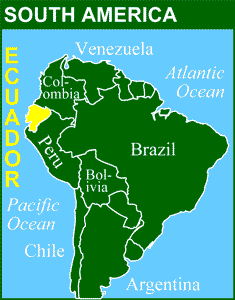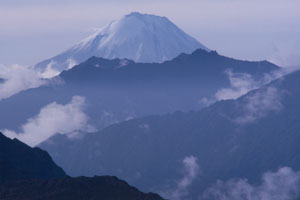 “Wayfarer, there is no path, you make the path as you go.”
“Wayfarer, there is no path, you make the path as you go.”
|
|
| English | Español | Deutsch | Français | Nederlands |
THE COUNTRY
- Why Ecuador?
- Slide Show
THE BOOK
- Foreword
- Preface
- Acknowledgments
- Table of Contents
- Trek Summaries
- Index
- About the Authors
- About the Publisher
A SAMPLE TREK
- Overview
- Route Description
- Topographic Map
- Elevation Profile
HOW TO BUY
THE BOOK
UPDATES
FEEDBACK
LINKS
CONTACT US
- The Authors
- The Publisher
© 2002-07 Kunstaetter
(From Chapter 1)

Ecuador's special appeal to trekkers, day-trippers, and nature lovers can be summed up in one word: accessibility. The country's unique combination of small size, exceptional geographic and biological diversity, and good transportation infrastructure places an outstanding variety of splendid natural experiences within easy reach of the adventurous visitor.
Ecuador boasts more than forty-five protected natural areas, including national parks and private reserves, almost all of which offer trekking and day-hiking possibilities. There are also innumerable opportunities for excellent day trips close to cities and towns. Many longer treks span several natural regions, from the highlands down toward the Amazon jungle or coastal plain.
Travel costs in Ecuador, although gradually rising, remain modest by international standards. Since the country is located closer to North America and Europe than the continent's other trekking destinations, airfares to Ecuador are also lower.
Ecuador receives many visitors (approximately 500,000 a year), but as yet relatively few people come specifically to trek. Unlike well-known trekking venues such as Nepal, the Inca Trail to Machu Picchu in Peru, and Chile's Torres del Paine National Park, trails in Ecuador are never crowded and offer virtually unlimited scope for exploration.
 |
| A rare glimpse of Sangay
from the north. (Treks 23, 24, and 25; Photo: RK) |
Trekking in Ecuador is easily combined with a visit to the country's more traditional destinations: the Galápagos Islands, colorful indigenous markets, Amazon jungle lodges, or Pacific coast beaches. Trekking options in Ecuador are as diverse as the country's natural areas. With altitudes ranging from sea level to more than 6000 meters (20,000 feet), there are tropical rainforests, cloud forests, high moorlands known as páramos, and rocky ridges right up to the snowline. The highlands offer the greatest number of trekking opportunities, and the Andes provide the perfect backdrop—with magnificent scenery and an incomparable top-of-the-world feeling. Trekkers often find themselves literally above the clouds!
Although Ecuador has wet and dry seasons, they are not the same in all parts of the country and may even vary from one valley to the next. Hence, conditions are suitable for trekking somewhere in Ecuador throughout the year.


